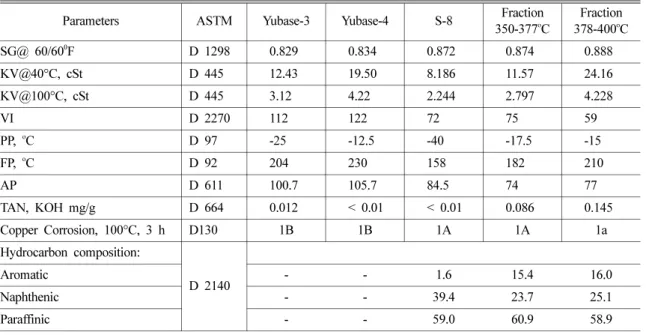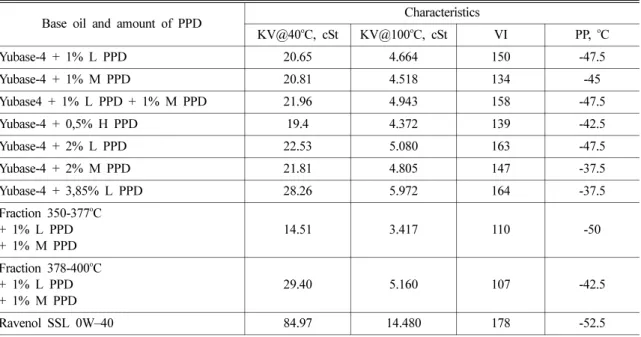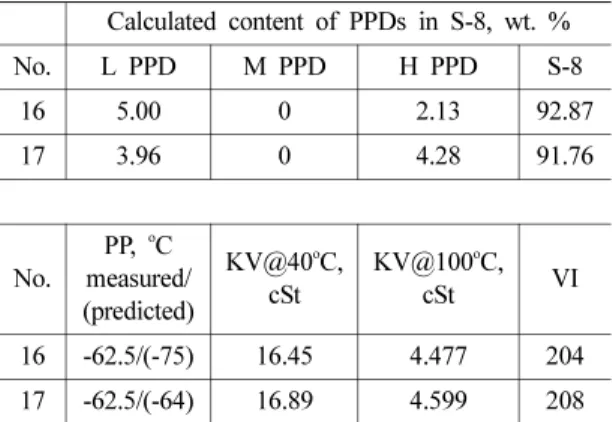DOI http://dx.doi.org/10.9725/kstle.2015.31.1.28
Possibility of Obtaining Lubricant Base Oil from Talakan Crude Oil Suitable for Exploitation in Extremely Cold Conditions
in the Republic of Sakha (Yakutia)
Zhirkov, N. P.
1†, Zakharova, S. S.
1and Zoo-One Sung
2#1
Department of Chemistry, North-Eastern Federal University, Yakutsk 677000, Russia
2
Buhmwoo Institute of Technology Research (BIT), Gyeonggi-do 718-106, Korea (Received December 11, 2014; Revised January 16, 2015; Accepted January 18, 2015)
Abstract − This paper addresses the problems of using anti-freeze lubricants for different machines that must function at extremely low temperatures during winter operation in the Republic of Sakha (Yakutia). We discuss the possibility of obtaining anti-freeze base oils from Talakan crude oil, an area with major oil and gas deposits of the Republic of Sakha, and also provide the trade and technological classification of Talakan crude oil. We propose two different schemes for processing Talakan crude oil: the fuel scheme (obtaining light and heavy frac- tions as a fuel oil) and the base oil scheme (obtaining light fractions and base oils). We investigate the influence of pour point depressants on alkyl-methacrylate base on the low-temperature properties of the fractions obtained from Talakan crude oil and Korean base oils, and establish the optimal concentration of pour point depressants.
We compare the properties of these fractions with the low-temperature properties of Korean base oils and find that the commercial oil “Ravenol 0W–40” provides optimistic results. We obtain oil with a pour point of minus 50°C and a viscosity index greater than 100. The Design of Experiment was used to establish the optimum com- position of the pour point depressants and the base oil S-8 to obtain lubricant oil with a kinematic viscosity of 17 cSt, viscosity index of 208, and a pour point of minus 64°C.
Keywords − talakan, anti-freeze, viscosity index, base oil, pour point
Nomenclature AP : Aniline Point
BP : Boiling Point FP : Flash Point
KV : Kinematic Viscosity PP : Pour Point
PPD : Pour Point Depressant SG : Specific Gravity TAN : Total Acid Number VI : Viscosity Index
1. Introduction
At present, the Republic of Sakha faces the task of developing the oil refining industry for production of high-quality motor fuels, lubricants, and raw materials for the chemical industry to develop its national econ- omy [1, 2].
Creating anti-freeze lubricants from local raw mate- rials is an important task, since the use of these lubri- cants would help resolve the problem of improving the reliability and durability of machines and mechanical devices in the extremely cold climates of the Republic of Sakha [3]. This republic needs to develop targeted technologies that are adapted to the chemical composi- tion of Sakha crude oils for producing anti-freeze lubri- cants that are efficient at temperatures as low as -60°C.
Talakan oil and gas deposits were discovered in the
†
![Table 1. Technological classification of crude in Russia [7] ClassContent ofSulfur, wt.%TypeFraction to 350oC, wt.%GroupBase oil content, wt.%SubgroupVI ofBase oilSort](https://thumb-ap.123doks.com/thumbv2/123dokinfo/5123482.334547/3.892.318.575.210.1088/technological-classification-russia-classcontent-ofsulfur-typefraction-groupbase-subgroupvi.webp)


